In the previous article, we spoke with veterinarians Lluís Ferrer and Joan Aparicio about the importance of health acclimation for the future breeding animals. In this article, we focus on the production aspects of gilt management.
Weight and age at first mating

Age and/or weight at the first mating is a parameter that is always under discussion and of great importance in the subsequent performance of the animals. We ask our experts about it:
Aparicio says that he adheres, up to a point, to the recommendations of the different genetic companies but, as a general rule, he recommends to perform the first mating at around 32 weeks of age and a weight of 140-150 kg. For him, an important goal is to achieve a first farrowing at 50 weeks of age.
For Ferrer it is crystal clear: "for me, the most important parameter is weight. My goal is 130-140 kg. You have to avoid animals that are too heavy and too fat. Most of the genetic lines we work with are very efficient in feed conversion. It is much easier to increase their weight than to make them lose weight." Ferrer prefers to mate animals that are a little short of their ideal weight since, in any case, they will catch up in the first half of gestation.
To that end, Ferrer considers feeding control during the gilt rearing phase a key factor. In particular, intake control from 110-120 kg weight. "When animals eat more than 3 kg of feed per day, we start to restrict their feed allowance."
Heat control before mating
Aparicio gives great importance to prior heat control.
The acclimation period is divided into 2 stages: the first 4 weeks of isolation, and the four following weeks of infection-acclimation. He says "in the isolation phase I want a visual heat control. Knowing the exact day the heat starts is not so important, but we want to know which animals are cycling and which ones are not. In the infecting phase, we must already control heats with the boar. "

Photo 1. Heat control during the acclimation period is one of the key farm management aspects. It allows inseminating the gilt on its second or third recorded heat. It also allows knowing which gilts are not cycling properly.
Aparicio says that in most of the farms they use the 3-colour system for heat control. Each week, animals on heat are marked with a different colour: red, green or blue. These three colours are rotated, so that we end up with matings and heats ordered by mating batch in a very easy and visual way. He likes the fact that the gilts on heat are already being marked in the same way in the acclimation building. So it is very practical to schedule the gilt introduction into the weekly mating batches.
Ferrer prefers to perform heat control from the first quarantine day. If done properly, the gilt must have at least two controlled heats before its service. "For me, this is a piece of information that indicates the quality of the work done during the acclimation."
Stall acclimation
A common recommendation from all the genetic companies to favour a good ovulation rate is to avoid feed restrictions for the sow 10-15 days before mating. This is incompatible with placing the gilt in a stall for the first time just a few days before its mating.

Photo 2. If the gilts are going to be mated and spend the first weeks of gestation in stalls, they must get used to them in the first place, so as avoid their placement in stalls interfering with the practice of flushing and with a good ovulation. The photo also shows the practice of marking the animals in heat that are not serviced with a different colour every week.
So, if gilts are going to be serviced in stalls, an important part of this acclimation process is the previous acclimation to the stalls.
Aparicio warns: "One of the evils of all farms is the lack of space. It is difficult, once the gilts are in the breeding barn, to have enough space to allow for all of them to spend at least 15 days in the stalls before mating". Therefore, the best way to proceed is to place the gilts in stalls already during the second part of their introduction protocol, in the acclimation barn. In this way, gilts get used to the stalls during health acclimation, through vaccinations, etc.
Ferrer remembers that, apart from the acclimation to stalls, in farms where the gestation groups have electronic feeding stations, the gilts must be trained to get into the station and eat from these machines before mating. He states that, based on his own experience, 4 weeks are necessary.
Flushing
The practice of flushing, the increase of the gilt energy intake before her first mating, is a practice that aims to improve ovulation and embryonic survival.
Ferrer insists on the idea that, on many occasions, stall acclimation is too short, making it impossible for the gilts to increase their feed intake significantly 10-15 days before mating. Alternatively, he recommends the use of 75-100 grams of sugar or dextrose the days before the gilt is expected to come into heat.
Heat detection and first service
The two veterinarians agree on this point: for gilts, they recommend heat detection and insemination every 12 hours. Cervical insemination, a very well stimulated gilt and always with a boar in front. Ferrer points out a practical detail that does not seem minor: in many farms, heat detection in gilts is performed after checking the sows. If the teaser boar used for both, sows and gilts, is the same one, it usually is already tired and poorly stimulated when checking the gilts.
Gilt Segregation
We asked the two experts their opinion on the practice of keeping the gilts separated from the multiparous sows, either in different buildings or different sections. This is a practice carried out on some farms for productive and health reasons.
Aparicio says he does not do gilt segregation. "I like to include the gilt in her mating batch right from her first mating day. Besides, from a health point of view, I do not see any advantages. I’d rather the gilt gets adapts gradually to the rest of the sows during the whole gestation period".
Ferrer agrees that, in his experience, segregation sometimes leads to problems in the second parity, because segregated gilts did not acclimatise to the farm during their first pregnancy. He does recommend, however, to keep gilts and multiparous separated during mating and the first month of gestation. Given that the AI techniques employed are different — cervical insemination for gilts and postcervical insemination for sows—, it facilitates management and, most importantly, it avoids the presence of scared or intimidated gilts due to them being placed beside larger animals.
In conclusion, there are many key points in the preparation of gilts before their first mating. Having a good start with this group of animals, that represent the future of the farm, depends on how well and consistenly we implement the many details that have to do with health, feed and management.





